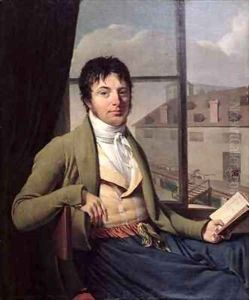Louis Bouchot Paintings
Louis-Pierre-Théophile Bouchot, commonly known as Louis Bouchot, was a French painter and illustrator born in 1817 in Paris. His artistic career spanned much of the 19th century, a period characterized by significant political, social, and cultural changes in France and across Europe. Bouchot was primarily known for his genre paintings, historical scenes, and portraits. His style was influenced by the Romantic movement that dominated the early part of the century, as well as by the realism that began to take hold in the mid-1800s.
Bouchot received his formal art education at the École des Beaux-Arts in Paris, where he studied under prominent artists of the time. He honed his skills in the academic tradition, which emphasized the importance of drawing and the study of the human figure. Throughout his career, Bouchot exhibited his works at the Paris Salon, the official art exhibition of the Académie des Beaux-Arts in Paris. His participation in these exhibitions helped to establish his reputation as a skilled painter.
Much of Bouchot's work was influenced by the events and figures of French history. He often depicted scenes from the French Revolution, the Napoleonic era, and other significant historical periods. As an illustrator, Bouchot also contributed to various publications, providing visual imagery that complemented the written word. His illustrations often featured historical and literary themes, which were popular among the French reading public of the time.
Louis Bouchot's artistic contributions were part of a larger 19th-century French art scene that included luminaries such as Eugène Delacroix, Jean-Auguste-Dominique Ingres, and later, Gustave Courbet and Édouard Manet. Although Bouchot may not have achieved the same level of fame as these contemporaries, his work nonetheless reflected the rich tapestry of French art during a period of great transformation.
Bouchot lived through the tumultuous years of the Second Republic, the Second Empire under Napoleon III, and the early years of the Third Republic. The political upheavals and social changes of these times inevitably impacted the art world and the kinds of subjects that artists chose to depict. Bouchot's death in 1907 marked the end of an era that had witnessed the transition from the Romantic sensibilities of the early 19th century to the burgeoning modernist movements that would define the 20th century. His body of work remains a testament to the eclectic and dynamic nature of French art during his lifetime.
